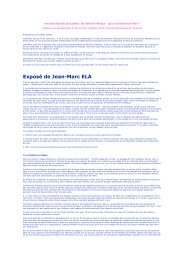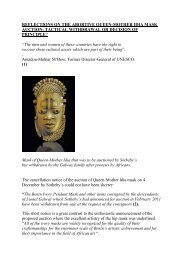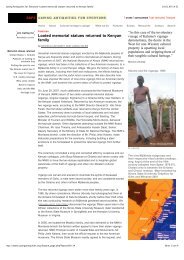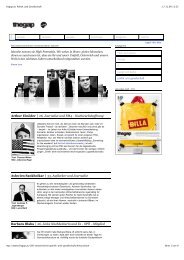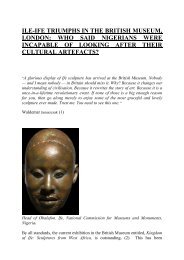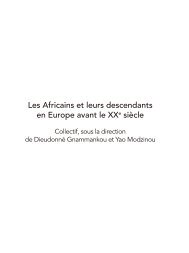White charity
White charity
White charity
- No tags were found...
Create successful ePaper yourself
Turn your PDF publications into a flip-book with our unique Google optimized e-Paper software.
construction of history and through not talking about a duty on the one side and a right on the other– which would imply a notion of reparation rather than donation – a good conscience instead of aguilty conscience is made possible for the white subject.identification: In the case of <strong>charity</strong> advertisements, the identification with the Other fails.Therefore Barthes' proposal of exoticism as evasion comes into play. With the invisible assumptionof white as normal, black people can be expelled to the peripheries. The representation of blackpeople as exotic on the other hand, manifests the presumed central position of whiteness. The powerof whiteness is visible in an arbitrary, “complex and ambivalent interweaving of assimilationisttendencies and rejectionism” (Goudge 2003: 157). Through the concept of 'developmentcooperation' 61 – in which charities define how development should take place – charities offer blackpeople the opportunity to become like white people. At the same time, however, they visuallyconfine them to the edges of humanity.tautology: The message of the advertisements is: 'Black people are poor, because it is like this'.Causalities are not discussed, hence charities manage through this rhetorical form to naturalisetheir definition of the black subject. Charities enjoy authority, first, as they depict themselves as(white) experts, who work “out there” (see Goudge 2003: 163) and second, because of therepetitious character of their advertisements, their own discourse.neither-norism: Charities keep silent in their ads about current global political structures. Onereason might be their philosophy that a shut mouth catches no flies, which lets them operateproblem-free inside Germany: it lets them cooperate with governmental institutions as well ascorporations. However, keeping silent about present forms of exploitation, unjust terms of trade andan unequal distribution of power, implies accordance with them. Not to forget that the viewer – andthe designer – of <strong>charity</strong> ads profit from these very global structures. This rhetorical formcontributes again to the de-politisation of white Germans as it confirms their political passivity asacceptable. By not taking an unequivocal stand on political issues, charities are able to appear as ahigh morality which awards them another degree of authority.quantification of quality: Charities seem to justify white superiority through a reference on thequantity of technology it generated, or contrarily, on the lack of technology of the Other. Having nomodern technology, or being depicted as such, seems a reason to be rendered inferior. The multitudeof technological devices is thus seen as the tool to measure the quality of life.statement of fact: Analogue to the figure of tautology, charities are able to position their assertionsas truth. Subjective world views are through the usage of the 'statement of fact' represented as61 An interesting question to follow for a further research would be the similarities, connections and interweavingsbetween the myth of whiteness and the myth of 'development'.30



